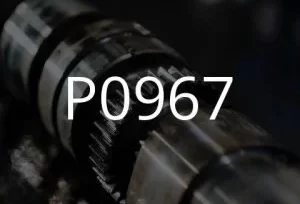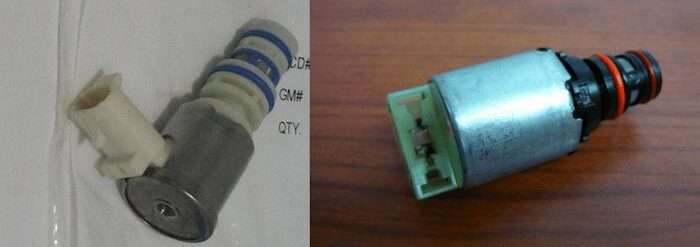
P0967 Pressure control solenoid valve "B" control circuit high
Content
P0967 – OBD-II Trouble Code Technical Description
Trouble code P0967 indicates a high signal level in the transmission pressure control solenoid valve "B" control circuit.
What does the fault code mean P0967?
Trouble code P0967 indicates a high signal on the transmission pressure control solenoid valve “B” control circuit. This means that the engine control module (PCM) has detected that the signal from the “B” solenoid valve is outside of acceptable limits. This may indicate a faulty or malfunctioning valve that will affect the proper functioning of the transmission pressure control system.

Possible reasons
Trouble code P0967 can be caused by various reasons, some of them are:
- Solenoid valve “B” malfunction: The valve itself may be damaged or malfunctioning due to wear, corrosion, or other problems.
- Wiring and connectors: Problems with the wiring or connectors connecting the “B” solenoid valve to the control engine module (PCM) can cause a high signal level in the circuit.
- Engine control module (PCM) malfunction: A malfunction of the PCM itself, which controls the transmission and receives signals from the solenoid valves, may also be the cause.
- Short circuit or open circuit in the control circuit: Damage to the control circuit, such as due to a short circuit or broken wiring, can cause a high signal level.
- Transmission pressure problems: It's possible that transmission pressure problems themselves, not directly related to the valve, can cause P0967.
- Grounding problems: Improper grounding of the transmission system or electronics can also cause signal problems.
These are just some of the possible causes, and additional diagnostics using specialized equipment are required to accurately determine the cause.
What are the symptoms of a fault code? P0967?
Symptoms that may occur with a P0967 trouble code may vary depending on the specific cause of the fault and vehicle specifications, some of the possible symptoms are:
- Gearshift problems: Uneven or jerky gear shifting may be noticed. Gears may not shift smoothly or may be delayed.
- Increased fuel consumption: Changes in transmission operation may result in increased fuel consumption due to improper gear shifting and engine operation.
- Acceleration delays: When you press the accelerator pedal, there may be a delay in the vehicle's acceleration response due to problems with gear shifting.
- Appearance of the “Check Engine” indicator: Errors related to the transmission or engine can cause the “Check Engine” light to appear on the dashboard.
- Unusual sounds or vibrations: There may be unusual sounds or vibrations coming from the transmission due to the pressure control system not functioning properly.
- Speed Limit: In some cases, the vehicle may go into limp mode or limit its top speed to prevent damage.
It's important to note that some of the symptoms listed may be common to many transmission problems, so further diagnosis is necessary to pinpoint the cause.
How to diagnose a fault code P0967?
To diagnose DTC P0967, you can follow these steps:
- Error scanning: Use an OBD-II diagnostic scanner to read trouble codes. Verify that the P0967 code is indeed present in the system.
- Visual inspection: Check the wiring and connectors connecting the “B” solenoid valve to the control engine module. Look for damage, corrosion, or broken wires.
- Checking the solenoid valve: Use a multimeter to check the resistance of solenoid valve “B”. Make sure the resistance meets the manufacturer's specifications.
- Checking transmission pressure: Use diagnostic equipment to check transmission pressure. Make sure the pressure meets the manufacturer's specifications.
- Engine Control Module (PCM) Diagnosis: If necessary, perform tests to identify problems with the engine control module, which controls the transmission.
- Checking other sensors and components: Use diagnostic techniques to check other components that may affect transmission performance, such as pressure and speed sensors.
- Checking the oil filter and transmission fluid level: Make sure the transmission oil filter is not clogged and the transmission fluid level is within the recommended range.
- Check for other fault codes: Check for other error codes that may be related to problems with the transmission or other vehicle systems.
Once the diagnostics are completed, you can determine the exact cause of the P0967 code and begin the necessary repairs or replacement of faulty components. If you are unable to solve the problem yourself, it is recommended that you contact an experienced auto mechanic or service center.
Diagnostic errors
When diagnosing DTC P0967, the following errors may occur:
- Skipping important diagnostic steps: Some of the key steps, such as checking wiring or transmission pressure, may be skipped, which can lead to incorrect conclusions.
- Lack of attention to detail: Failure to pay attention to details, such as the condition of connectors or wiring, can lead to important points being missed or misdiagnosis.
- Incorrect interpretation of results: Misinterpretation of test or measurement results may lead to incorrect conclusions about the health of the system.
- Malfunction of diagnostic equipment: Faulty or uncalibrated diagnostic equipment may produce inaccurate results, which can make diagnosis difficult.
- Wrong choice of solution: Choosing the wrong course of action to correct a problem based on incomplete data or misdiagnosis can result in unnecessary costs for repairs or replacement of components.
- Lack of professional knowledge: Insufficient knowledge about the operation of the transmission and electrical systems of the vehicle can lead to errors in diagnosis and repair.
To avoid these mistakes, it is important to follow professional diagnostic and repair recommendations.
How serious is the fault code? P0967?
Trouble code P0967 is serious because it indicates a problem with the transmission pressure control solenoid valve “B”. Depending on the specific cause of the error and its impact on transmission performance, the severity of the problem may vary. Some of the possible consequences of the P0967 trouble code:
- Irregular gear shifting: Improper operation of the solenoid valve may result in uneven or jerky gear shifting, which may affect driving comfort and safety.
- Increased transmission wear: Incorrect transmission pressure can cause increased wear on components such as clutches and discs, which can lead to early transmission failure.
- Loss of control of the vehicle: In some cases, transmission problems can cause you to lose control of your vehicle, especially if the transmission behaves erratically on the road.
- Degraded performance and fuel economy: Improper transmission operation can result in poor engine performance and fuel economy.
- The need for expensive repairs: If the transmission is not functioning properly, the solenoid valve and other components may require expensive repairs or replacement.
So, although the P0967 trouble code is not an emergency, its severity lies in the potential implications for the performance and safety of your vehicle. Therefore, it is recommended to carry out diagnosis and repair immediately to avoid further problems.
What repair will help eliminate the code? P0967?
The repair that will resolve the P0967 trouble code will depend on the specific cause of this error, several possible actions that can be taken are:
- Replacing or repairing solenoid valve “B”: If the problem is a problem with the valve itself due to wear, corrosion, or other reasons, it can be replaced or repaired.
- Checking and replacing wiring and connectors: Check the wiring and connectors connecting the “B” solenoid valve to the control engine module. Damaged or broken wires or connectors should be replaced.
- Checking and servicing transmission pressure: Make sure the transmission pressure meets the manufacturer's specifications. If necessary, the pressure can be adjusted or set to normal limits.
- Engine Control Module (PCM) Diagnosis and Service: If the problem is due to a faulty PCM, you can try to repair or replace it.
- Checking and replacing other components: If necessary, check and replace other transmission components, such as the oil pump filter or oil pump.
- Check for other fault codes: Check for other error codes that may be related to problems with the transmission or other vehicle systems and begin troubleshooting them.
It is important to contact a qualified auto mechanic or service center to diagnose and determine the exact cause of the problem so that you can carry out the correct repairs and avoid further negative consequences.
P0967 – Brand specific information
Trouble code P0967 can occur on various brands of cars, several examples of car brands and their interpretation:
- Toyota / Lexus: Transmission pressure control solenoid valve “B” control circuit is high.
- Honda/Acura: Transmission pressure control solenoid valve “B” signal is high.
- Nissan / Infiniti: Transmission pressure control solenoid valve “B” signal is high.
- Ford: Transmission pressure control solenoid valve “B” circuit is high.
- Chevrolet / GMC: Transmission pressure control solenoid valve “B” signal is high.
- Volkswagen / Audi: Transmission pressure control solenoid valve “B” signal is high.
- BMW / Mercedes Benz: Transmission pressure control solenoid valve “B” circuit is high.
Each manufacturer may have its own interpretation of fault codes and specific solutions to resolve them. Therefore, it is recommended that you consult the official repair manuals for your specific vehicle make and model for accurate information and repair recommendations.
One comment
Wagner
Hello .. Good evening
I'm Nissan Sentra 2014
CVT gearbox
With this code p0967, the valve body, filter, oil and gearbox module have already been replaced.
But it didn't solve